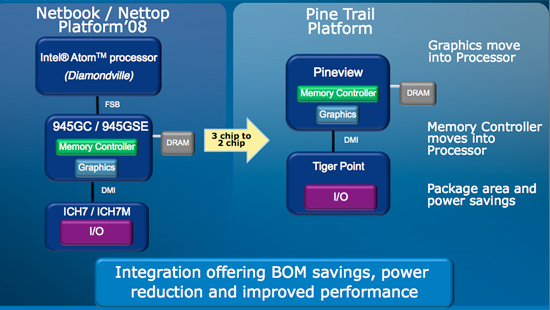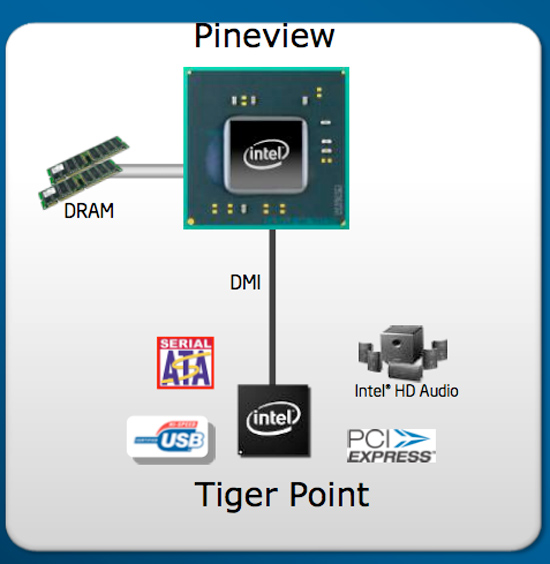Intel Unveils Next-Generation Atom Details
by Anand Lal Shimpi on May 19, 2009 12:00 AM EST- Posted in
- CPUs
Today Intel unveiled a few details about its next-generation Atom platform for netbooks and nettops. The current Atom platform for netbooks/nettops is composed of three chips: the Intel Atom processor, Intel’s 945GC GMCH and the ICH7 I/O hub. The UMPC version of the Atom platform is a two chip solution that uses the US15 chipset in addition to the Atom processor.

Let’s first start with breaking down the codenames. The new Atom platform for netbooks/nettops is called Pine Trail. Pine Trail refers to the combination of CPU and chipset.

The CPU in this case is the next version of the Atom core. Still based on Intel’s 45nm process, this new Atom (codenamed Pineview...yes, confusing) brings both the memory controller and GPU core on-die. The current Atom for netbooks/nettops is codenamed Diamondville.
The Pineview CPU connects over Intel’s DMI to its new South Bridge, codenamed Tiger Point.
Intel wasn’t very specific about the memory controller or graphics core in Pineview but I’m guessing we’ll see a single-channel DDR3 memory interface and perhaps some evolution of the current Intel GMA core. Since the chip is still a 45nm part, it’s feasible that Intel could integrate the same GPU being used on its upcoming Westmere processors which is also 45nm.
The 945 GMCH used on current Atom platforms is built on a 130nm process and draws more power than the Atom CPU itself. Intel’s first mini-ITX Atom boards use a bigger heatsink on the GMCH than they do on the Atom CPU:

The tall heatsink in the back is for the chipset, the small one is all you need for the CPU
Bringing the graphics core on-die will help significantly reduce thermal output. Intel is expecting many more fanless netbook/nettop designs thanks to the change. Another side effect is that the new Atom platform will be easier to implement using a 4 layer motherboard. Currently many Atom designs use 6-layer motherboards, which are more costly to manufacture.
Remember that the Atom processor is an in-order architecture, making its performance very dependent on memory latency. The move to an on-die memory controller should significantly reduce memory latency and thus have a very positive impact on performance. Atom doesn't aggressively prefetch like Intel's high end desktop processors, so long trips down memory lane are very painful.
Intel is expecting to see the first previews of Pine Trail based netbooks/nettops at Computex next month. If you’ve been thinking about a netbook/nettop and don’t need one right away, you may be better served by waiting until the end of this year.










26 Comments
View All Comments
RadnorHarkonnen - Tuesday, May 19, 2009 - link
Wikipedia is not the most reliable but:x86-processors for both regular PCs and embedded designs
Intel
AMD
VIA
Transmeta (discontinued its x86 line)
Rise Technology (acquired by SiS)
IDT (Centaur Technology x86 division acquired by VIA)
National Semiconductor (sold the x86 PC designs to VIA and later the x86 embedded designs to AMD)
Cyrix (acquired by National Semiconductor)
NexGen (acquired by AMD)
Chips and Technologies (acquired by Intel)
IBM (discontinued its own x86 line)
UMC (discontinued its x86 line)
NEC (discontinued its x86 line)
x86-processors for embedded designs only
Zet IA-32 (Zet is a GPL open source FPGA implementation targeting the Xilinx ML403 and Altera DE1) [1]
ZF Micro (ZFx86 - Cx486DX SoC)
Nvidia (M6117C - 386SX)
ALi (x86 products went to Nvidia through the ULi sale)
SiS (discontinued its Vortex86 line)
D&MP Electronics (continues SiS' Vortex86 line)
RDC Semiconducters (R8610 an R8620)
Manufacturing-only of x86-processors designed by others
IBM (manufactures processors for ZF Micro and VIA; discontinued production for NexGen and Transmeta)
TSMC (manufactures processors for VIA; discontinued production for Transmeta)
UMC (manufactures processors for Nvidia; discontinued production for Rise, SiS, ALi and ULi)
Fujitsu (manufactured processors for Transmeta; discontinued x86 production)
National Semiconductor (manufactured processors for ZF Micro; discontinued x86 production)
Manufacturing and selling under its own name of x86-processors designed by others
IBM (designs by Cyrix; now this line is discontinued)
SGS-Thomson (designs by Cyrix; discontinued x86 production)
Texas Instruments (designs by Cyrix; discontinued x86 production)
I just see too many loose ends here. Nvidia just need to tak ethe right step. Like after Intel being slapped with monopolists processes. Japan, Korea, now Europe. Just wait until somebody in the US start ticking.
I honestly can see Nvidia doing a x86. No problem. And i believe they have the personel to do it.
bobvodka - Tuesday, May 19, 2009 - link
The problem for NV is they don't have the rights to produce an x86 compatible CPU due to IP issues.I also very much doubt they could do it 'before the end of the year' as well.
sprockkets - Tuesday, May 19, 2009 - link
What you need to state is whether this chipset supports SATA. If not, this isn't going to be a great desktop chipset. Or, perhaps it will depending on the south bridge, in which case, nVidia could still plug in anyhow via an ION without a memory controller.danielsun174 - Monday, November 9, 2009 - link
yeah, u are absolutely right !! http://www.eiweiss-protein.de/">http://www.eiweiss-protein.de/jhon1234 - Wednesday, May 27, 2009 - link
http://www.easylawyers.co.uk/resources/freehold-pr...">http://www.easylawyers.co.uk/resources/freehold-pr...http://www.easylawyers.co.uk/resources/leasehold-p...">http://www.easylawyers.co.uk/resources/leasehold-p...
http://www.easylawyers.co.uk/resources/buying-prop...">http://www.easylawyers.co.uk/resources/buying-prop...
http://www.faqts.com/knowledge_base/view.phtml/aid...">http://www.faqts.com/knowledge_base/view.phtml/aid...
ltcommanderdata - Tuesday, May 19, 2009 - link
It's hard to see nVidia bothering to produce an IGP for Pineview. The DMI link is meant to attach a southbridge and is relatively low bandwidth being equivalent of a PCIe 1.1 x4 bus. An nVidia IGP would no doubt saturate the bus, especially if it has to go through DMI to access the on-CPU memory controller.This is actually going to be an increasing problem since mainstream Nehalem like Lynnfield don't include CSI and only have DMI which will make it difficult for nVidia to make IGPs even if they figure out their chipset licensing issue with Intel. Future chipsets will largely be relegated to southbridges, which isn't exactly glamourous or allow much product differentiation for nVidia.
A compromise might be a southbridge with an IGP and it's own memory controller for a small amount of dedicated graphics memory like AMD's Sideport. That would of course increase cost and require more board room for those memory chips even if they are soldered on the motherboard rather than slotted.
Spivonious - Tuesday, May 19, 2009 - link
Look at the graphic. SATA is clearly marked as being present in the chipset.sprockkets - Tuesday, May 19, 2009 - link
It might be in the graphic, but previously it was mentioned it would not be there.Even though it is in the picture, I want confirmation. They wanted to leave SATA out since it takes more power, and they were wanting to make this particular Atom more of a MID chip, and not a desktop chip.
whatthehey - Tuesday, May 19, 2009 - link
Yes, but does it support HD audio, USB, or PCI Express!? ;-)Actually, this is very interesting. After all of the "you can only integrate the memory controller once" and "it locks you into a specific memory type" talk from Intel back in the Athlon 64 era, now they're taking that route with their ultra low power CPU/platform.
Also interesting to note that this basically kills off much of the market for stuff like, oh, I dunno... maybe NVIDIA Ion? That's pretty brutal, and there's nothing anyone can do about it. Now NVIDIA is cut out of the Intel desktop chipset business, more or less, since they can't make DMI compatible chipsets (to my knowledge they don't have rights to do so), and Intel is doing the same with Atom. NVIDIA better hope AMD sticks around is all I can say!
Anonymous Freak - Tuesday, May 19, 2009 - link
Well, from previous AMD reviews, we know that DDR3 is backward compatible with DDR2 at the chipset level, so all it takes is board design differences. (Socket AM2+ vs. AM3.)If Intel puts a DDR3 controller in it, then they can go with DDR2 now, and DDR3 when it gets cheaper.